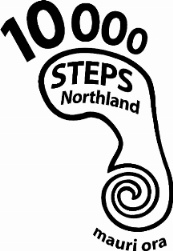

10,000 STEPS
Best New Zealand Walking Promotion
10,000 STEPS NORTHLAND
(Winner of the 'Best New Zealand Walking Promotion' Living Streets Aotearoa Golden Foot Awards - New Zealand National Walking Awards 2009)
A concept of trying to move more and accumulate 10,000 steps over the course of the day. This is from the time that you get up in the morning and go to bed in the evening.
If you are not very active right now, that's OK. It is important to start out slowly and gradually increase your activity over time.
Even small increases in your daily activities can have a big impact on your health - small sustainable steps for life!
Many people can reach 10,000 steps a day by adding a 30-minute walk to their everyday activities.

HOW MANY STEPS SHOULD I TAKE & WHY?
Evidence suggests that.....
Healthy adults should step towards achieving 10,000 steps each day.
Children and adolescents should aim for more, approximately 12,000 -15,000 steps a day.
Older adults should aim for a little less than 10,000 depending on their mobility. *If you are older or have a health problem or a disability ask your doctor about modifying the target.
(This is from the time that you get up in the morning until the time that you go to bed in the evening).
While working towards your 10,000 steps each day, it is important to include at least 30 minutes of moderate physical activity.
That means that you:
- will puff (but still feel ok)
- warm the body up
- elevate the heart rate (work the heart harder)
Steps achieved in 30 minutes of moderate physical activity are your puffing steps, while all of your other steps are your puttering steps.
If you are not very active right now - ITS OK! Scroll down the page to find out how to become more active.
Some of us manage about 3,000 steps each day - walking to the car, walking to get food/drinks, around the workplace or home.
Alot of 'action' has been replaced by easier options and as a result of this inactivity, we are less fit and becoming more overweight, resulting in suffering from many of the health problems which result from too much sitting
WHAT DO WE MEAN BY ACTIVE?
Physical activity means any bodily movement produced by your skeletal muscles and resulting in energy expenditure.
Exercise means strutured / planned repetitive activity to maintain or improve fitness compnents.
Have you heard of the Foot – Brain Gap? It’s not that people are trying to be dishonest, but….. did you know that we tend to OVER – REPORT how active we are (40% males, 20% females). Regardless if you are moving or exercising, volume is the key.
Volume = Intensity x duration x frequency
Cover all your bases and do a variety of volume, which means within a week……do:
Some long slow sessions
Some short fast sessions
Several different activities
Plus as much step puttering as possible
BENEFITS OF WALKING
If you regularly monitor your activity and achieve your steps goals you will:
- Feel less tired and have more energy for everyday tasks
- Feel more confident and be less stressed
- Sleep better
- Have better heart health (including cholesterol and blood pressure)
- Find it easier to maintain a healthy weight
- Have stronger bones and muscles
- Reduce your risks of many serious health problems in old age
Increasing your daily activity can:
- Help people achieve and maintain a healthy body weight
- Reduce the risk of developing coronary heart disease (CHD) and the risk of dying from CHD
- Reduce feelings of depression and anxiety
- Reduce the risk of stroke
- Reduce the risk of having a second heart attack in people who have already had one heart attack
- Lower both total blood cholesterol and triglycerides and increases high-density lipoproteins (HDL) or the "good" cholesterol
- Lower the risk of developing high blood pressure
- Help reduce blood pressure in people who already have hypertension
- Lower the risk of developing non-insulin-dependent (type 2) diabetes mellitus
- Reduce the risk of developing colon cancer
- Promote psychological well-being and reduces feelings of stress
- Help build and maintain healthy bones, muscles, and joints
- Help older adults become stronger, and better able to move about without falling or becoming excessively fatigued
HOW EASY IS IT?
To increase daily steps each day it can be as easy as increasing steps by 10 - 50 per day until you can average 10,000 per day.
Example: If you currently average 3000 steps each day your goal for:
- week one could be to increase by 50 steps each day
- week two could be to achieve 3200 steps each day
Continue to increase at an achievable rate each week. For some people it could take months maybe even years to sustain 10,000 steps. Look for as many opportunities to get more steps in so that you are 'stepping towards' achieving 10,000 steps everyday.
Wearing a FitBit, Garmin or pedometer is an easy way to track your steps each day. Start by wearing the device every day for one week. Put your device on when you get up in the morning and wear it until bed time - only remove it if you are going for a swim, bath or shower.
Record your daily steps in a log - because the number of steps you take will vary each day you will need to wear your device for 2 week days & 2 weekend days to work out your average daily step count. By the end of the week you will know your average daily steps. You might be surprised how many (or how few) steps you get in each day.
There are many ways to increase your daily steps. Use your imagination and come up with your own list:
- Take a walk
- Walk the dog
- Use the stairs instead of the elevator
- Park farther from the shop
- Better yet, walk to the shop
- Get up to change the channel
- Window shop
- Plan a walking meeting
- Walk to the neighbours place
- Walk over to visit a neighbour
Continue to track your daily steps and keep notes on how you feel, how your body is improving, or other changes you are making to improve your health.
If at any point you feel that you are progressing too rapidly slow down a bit and try smaller increases. If you have any health concerns seek your physician's advice prior to starting or changing your exercise routine.
NORTHLAND WALKING GROUPS
Bay of Islands
Bay of Islands Runners & Walkers
Saturday (AM), Bert Vanasche 09-404-0147, or Gea Hadderingh 09- 405-7773
Dargaville
Dargaville Tramping Group
Last Sunday of month (AM), Lynley Thompson 021-102-3974, colvilleestate1@gmail.com
Whangarei
Cardiac Care Walking Group
Wednesday (AM or PM), Jo or Hugh Knight 09-438-7976
GREEN PRESCRIPTION Walking Group
0800-228-483
HARRIERS Walking Group
Tuesday (AM), Wednesday (PM), Thursday (AM), Val Babe 09-437-1657
HIKURANGI Walking Group
Tuesday (PM)
KAMO 60’s UP
Monday, Thursday (AM), Yvonne 09-435-1101
TIKIPUNGA Walking Group
Tuesday (AM), Barbara Derrick 09-435-0746
WAIPU Walking Group
Wednesday (AM)
WHANGAREI Tramping Club
Sue Guyatt 09-436-1441
Great Barrier Island
BARRIER TRAMPING CLUB
Sunday, John Brock 09-429-0211
SPORT NORTHLAND
CDL Group Northland Sports House
97 Western Hills Drive, Kensington,
Whangārei 0112
info@sportnorth.co.nz
CDL Group Northland Sports House - 09 437 9600
McKay Stadium / Kensington Fitness - 09 437 4404




 Members
Members Admin Login
Admin Login